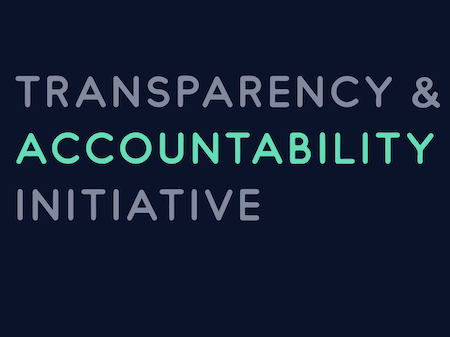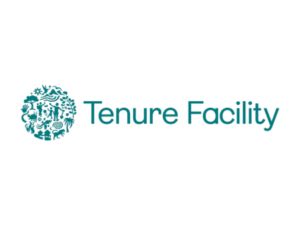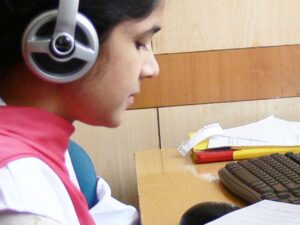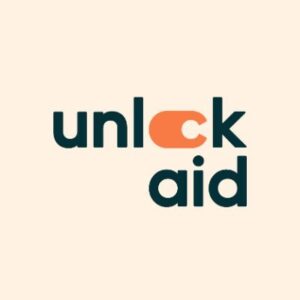The Transparency & Accountability Initiative is a group of donors supporting participation, openness and accountability efforts around the world.
Michael Jarvis of Transparency & Accountability Initiative spoke with Jessica Kantor on April 13, 2023. Click here to read the full conversation with insights highlighted.
Jessica Kantor: Can you please introduce yourself, your role in your organization, and the problem that your work addresses?
Michael Jarvis: I’m Michael Jarvis. I’m the head of something called the Transparency and Accountability Initiative, which is a collaborative of funders that work together to promote transparency, participation, and accountability around the globe. It’s done in response to a host of problems where the lack of those principles lead to losses, to corruption of huge amounts of money that should be going towards development, to services that aren’t designed properly for the needs of people around the world. At the community level all rights that are getting violated with impunity are affecting people’s daily lives. We believe that if you can build up a system that has transparency, community participation, and mechanisms for accountability from the beginning, you can actually head off a lot of those problems occurring.
Jessica Kantor: How exactly do you engage with the community and service the community in order to make that happen?
Michael Jarvis: We are one step removed in that we are looking for investable opportunities that can go to scale and take those principles to multiple countries and to multiple sectors. But I can share some examples of what that looks like in practice. We helped someone to work with the White House in the US and develop what became the open government partnership, which is now a network of over 70 countries around the world where commitments are made to open up the government and to build trust with citizens. Those commitments are designed jointly by government representatives and community representatives. Similarly, there’s an oversight mechanism for them to actually test if those commitments are being followed through an independent structure that also has government and citizen participation. What we find is that when you co-create those commitments, it builds up a level of trust and engagement that leads to higher fulfillment of those commitments than you get in a normal government procedure.
This innovation is now in over 70 countries and it’s also being grown out at local levels. We have cities who are signing up to do this, not just national level governments, and in many ways that’s where it works even better because you are closer to the direct communities and the local politicians and local government representatives who can build a more effective way of working with the support of civil society groups, with the support of journalists, and a number of other actors that have a role to play. It’s these kinds of processes that we want to invest in and encourage others to.
Another example would be something that sounds very dry and boring to people, which is procurement, how money gets spent by governments. Every year around the world there’s over $13 trillion that gets spent by governments. That’s one in three US dollars spent globally is government spending. But it’s not a topic that people pay a lot of attention to and it’s been one that’s had a lack of transparency and accountability around it. We advocate for and partner with governments to open up those procurement processes and allow for more meaningful participation. What you find is a whole spillover set of benefits. For example, it’s not just getting more value for money, although you do, we looked at projects in Peru where there was an independent analysis and those that had transparent procurement processes and monitoring of those procurement saved 51% of the total cost of those public works contracts compared to those contracts that weren’t transparent and supervised. We know that it can save important taxpayers dollars, which can go towards better development outcomes, but there are also other kinds of benefits. As soon as you understand who’s winning government contracts, you can analyze who they are and make tweaks in the system that actually lead to more diversity of who has access to providing government services and winning those bids.
We find that there’s a significant uptick in the diversity of who wins government contracts, often around 45%, when you make the systems publicly available and show people who’s winning. Maybe that’s just because those awarding the contracts are more cognizant of who might be paying attention, or maybe it’s just because the data’s now available. You can set a target and say, we want to increase the number of women owned businesses that are winning government contracts, and you actually now have a way of tracking that and making that visible to the public. Similarly now on climate, we’re finding that by having these procurement systems be open and more participatory, you can also think about how to engage and build in aspects to it that would ask questions around the consideration of climate impacts in the award of a contract.
By putting those kinds of prompts into the system when you’re awarding contracts, you start to influence behaviors and how people make the ultimate decisions and where the money goes. There are a myriad of ways in which you can get these different kinds of social benefits, but you need to improve the systems and you need to have citizens who are actively involved in tracking and monitoring and asking the questions to go with those within the government who are making that information available.
Jessica Kantor: How are you measuring success?
Michael Jarvis: We think about it in multiple ways. One measure of success is the uptake of solutions that we have seen tested and our members have funded to be piloted. But then we want to see the scale and the citizen oversight mechanism. Let’s take the example of Ghana in West Africa where we’ve built a model of how they can engage with local mining companies, ensure there’s transparency around everything from how jobs are being created to how much water is being used from local water supplies by the mine to how much money is being generated and where that money is going.
We’ll look at where we know a model is working and there will be commissioned evaluations and independent analysis of that. A success for us would be to replicate that, to find other contexts where that might be appropriate or can be customized and scaled up. Our members fund globally, so we’re looking across Latin America, sub-Saharan Africa, and parts of Asia. Often you’ll find the same issues cropping up in different geographies. So one measure of success is the uptake of these different solutions across those different geographies and providing spaces for them to learn and compare and evolve their work together.
Another metric is to think about some of these headline numbers that can wake up a donor community or wake up a government minister to pay attention, such as money saved. There was a case in Peru where we found you can spend half as much and get the same benefit as if you don’t have some of these measures built in. Again, that’s with an eye of encouraging more countries to take up these procedures and more funders to support this type of work. But ultimately it’s about how do you empower people to engage more and push for their own rights and take agency in these processes? Often the most compelling stories are those where, by building up local NGOs and coalitions of actors around one particular aspect, you then create a legacy of them recognizing that they can have a voice, they can make a change, and they can take that onto other issues of their own accord.
Those coalitions take on a life of their own, and then you don’t need that funder support anymore. Ideally it should be catalytic and, when it works well, that tends to be the case. We’re also looking to help build the infrastructure across journalists, across civil society, advocacy groups, across community leaders. Does that get sustained and does that become something that they use to continue to push for improvements on a whole range of issues, not just maybe where it started from? That civic infrastructure is the legacy that we’re looking for and probably the ultimate success.
Jessica Kantor: What are some lessons that you learned along the way, either early on or some recent issues that you came across, that you were able to solve that other people could possibly learn from?
Michael Jarvis: Providing a positive framing has been really helpful. Often you tend to come in with a deficit framing. So you’re saying, “We’re worried that you are losing X amount to corruption, we’re worried that these companies are able to act with impunity and that’s leading to deforestation.” The attention always tends to be on highlighting the problem as the motivation for action. What we found is actually you can get more sustainable results and more community engagement if you go in with a positive that we could build. You are going to have government services that more directly respond to your community needs if you are able to engage in these processes, take the time and investment. It is making an ask of people to be able to do this and celebrating the wins as you go.
That can extend into government and politicians as well. There’s a great program that some of our member funders support called Integrity Icon, that is run by a group called Accountability Lab who’ve been innovating in this space. Its ethos is asking people to nominate and celebrate government officials and bureaucrats who are going that extra mile, who are acting with integrity, who are really fighting for the communities that they represent and trying to improve systems that deliver that. Often that work is uncelebrated, so even by highlighting those positive cases, you start to open up a world of what’s possible to people, what should be the expectation, and shift some of that perception, which tends to be that bureaucrats are corrupt or they’re lazy. For the vast majority that’s not the case.
If you can shift those public perceptions, you actually end up having a more positive relationship and the potential for better outcomes on whatever issue it is that you particularly care about, women’s rights or the environment or education, for example. Positive framing and drawing attention to those positive deviance examples. Another has been about investing in the spaces for learning and bringing different stakeholders and groups together, which builds trust. And those relationships pay off in ways that you don’t anticipate going in.
It can often be hard to justify because people immediately wonder, “What’s going to be the return on that investment? Getting people together is expensive.” You have to ask for a leap of faith because it is hard to predict exactly what’s going to come out of relationship building and collaboration support. But our experience is that it does pay off. You need some patience, and it will create effects that you may not even anticipate going in, but which actually could be some of the most impactful things in the end. Investing in those spaces for relationship building, for learning and understanding different perspectives around the problem that you’re trying to solve, those are definitely worth the investment. There aren’t enough people who support that work, but for where it does, it pays off.
Jessica Kantor: Are there any challenges that you have faced that you haven’t been able to overcome? Any limitations currently?
Michael Jarvis: There are several. We know that mobilizing citizens and people to engage pays off, but you’re still asking them to give up time. And these are people who have a lot of other pressing problems on their plates. It could be feeding their families, it could be conditions in their neighborhood that they’re dealing with. How you help persuade those people to engage and try to incentivize that. And you need a range of people involved because if it’s only a certain section of a community you engage with, you’re not getting the full picture and you’re probably not going to see the full set of benefits. We’re still finding ways of motivating that participation in a way that feels a reasonable ask of people.
There’s a challenge of the context. A lot of this relies on a space for challenging the government or corporate practices, a space for debates, a space for civil society groups to advocate, to serve as watchdogs, for communities to assert their rights. Sadly, in many parts of the world, the space to do that is increasingly restricted. And that is a challenge, because then you’re asking people to take a risk that could mean they end up in jail or worse, so you need to be very responsible as a donor in thinking about what you can ask in that regard. We need to be thinking about how we keep those spaces open. How do we encourage and incentivize governments and others to allow freedom of expression, to allow citizen mobilization? That has knock-on effects for if you care about democracy, if you care about fighting climate change, it’s a fundamental cross-cutting issue that we’re all going to have to work on, but at the moment we may be losing that battle.
The last one is just mobilizing funder interest on these issues because most funders want to jump to the tangible feel good factor, understandably, and the quantifiable results. They want to see more children graduate from college and school, they want to see X vaccinations, they want to see cleaner air. And what we are really talking about is building an ecosystem and infrastructure that enables all of those things to happen more effectively, but they’re not the end result in themselves. They’re the enabling pieces that allow those things to happen.
Ideally we would want 5% of any development funding to go to these core issues that design and create space for citizen feedback and engagement and accountability that will ensure all of them have stronger chances of success. But persuading funders that that’s worth investing in and motivating them to see that as a priority is a challenge. Our collective is quite small. There aren’t that many funders who think about good governance and innovation in that space as their raison d’être. That’s something that we’re making progress on slowly but surely, but it’s still a challenge.
Jessica Kantor: How do you think your work is going to evolve over the next five years?
Michael Jarvis: I would hope five years from now there’d be a bigger set of funders who see the importance of building transparency, participation, and accountability into the DNA of everything they fund and asking the questions of their partners about how they do that. It models in a way how funders should operate themselves. These are principles that they should uphold in their own way of working, not just to ask of others. There could be some bigger facilities that could enable that work. A bigger pooled fund that can help civic mobilization and keep space for citizens to be able to engage and work safely in their environments.
We’re seeing a lot of piecemeal efforts and I would hope five years from now, some of those will come together and be able to work a bit more effectively at scale. We want to see more success stories coming from more diverse geographies. And there are inspiring cases out there. I’ve talked about procurement and government contracting, one of the leaders in that space is Ukraine. They have a system that is one of the world leaders in being able to analyze and see where Ukrainian government money is going. What’s been amazing is that they found ways to keep that going and they’re still being transparent, even in the context of war spending within reason for national security reasons, but they’re still being transparent about how spending is being made.
A lot of the trust that has been built by their measures, like the perceptions of corruption in government spending at HAFs in the years since they introduced this open procurement policy and platform. Those benefits seem to pay off in terms of social capital and public goodwill and trust in the government, which in a context of wartime becomes even more important. It’s amazing how people find ways to keep going once they see the value in it, even in the most difficult circumstances. I hope that we’ll have built the bones and infrastructure that allows that to happen in more contexts.
Hopefully not many face as extreme circumstances as a war, but it will put them in a better place with whatever challenges lay ahead. It could be rising sea levels for certain countries that are going to create all kinds of tensions and hard choices that need to be made. And if you find ways to rebuild some of this trust between government and citizens and provide the checks and balances and spaces for input, then they’re going to be better able to deal with those challenges. If we can prioritize where we do some of that investment, as I say, create a platform for that to happen, then that would be a big win.
Jessica Kantor: For the sake of this conversation and allowing others to learn from the work that you’ve done, is there anything that we didn’t speak about that you think is very important for them to know?
Michael Jarvis: Maybe it’s just that I’m speaking here at the Skoll Forum, where there’s a lot of talk of social entrepreneurs and innovation, and I think entrepreneurship and innovation can also apply and have ripple effects within government systems, within the apparatus of things that people might not normally pay attention to, but which actually could make real differences. Entrepreneurship does not necessarily need to be setting up an enterprise that scales to 50 different countries. It could be innovations in how you think about incubating the next generation of political leaders and in the long run that may have far greater impact if those people come into power than what any one enterprise or entity or NGO can do. I think we need that entrepreneurial approach and should be looking for ways to encourage people who have ideas to do things better across all sectors.
That includes the government, that includes civil society, and that includes the private sector. It can happen in a bureaucracy, it can happen in a government ministry, and it can happen at the community level amongst traditional leaders. We should be open in thinking about where that innovation can happen and how we can support it. It’s really about bringing that together with change makers in other sectors and other stakeholders that together will make a big difference.
Jessica Kantor: Thank you so much for sharing the work that you’re doing and what you’ve learned.
Click here to read the full conversation with insights highlighted.
Jessica Kantor is an independent journalist specializing in health, human rights, and social impact. Her work can be found in Fast Company, Healthcare Quarterly, The Las Vegas Review-Journal, and others. She is a living kidney donor.
* This interview has been edited and condensed.







